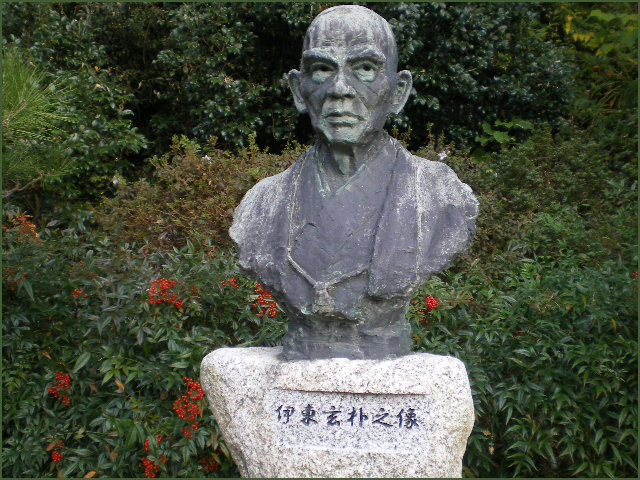[ . BACK to DARUMA MUSEUM TOP . ]
. Onipedia - 鬼ペディア - Oni Demons - ABC-List - .
::::::::::::::::::::::::::::::
Shinto and Oni 神道と鬼
. kami 神 Shinto deities / Japanese gods .
kami to oni 神と鬼 the Deities and Demons of Japan
. torii no oniko 鳥居の鬼コ Demons of the Shinto Toorii gates .
..... 鬼子 - also read as kishi and onigo
. jinja - list of Shinto shrines with ONI . *
::::::::::::::::::::::::::::::
- quote -
Oni
A misshapen supernatural demon or devil visiting this world from the other world, bringing with it disaster or blessing. Due to their fearful spiritual power, oni were considered ambivalent beings possessing the power of both good and evil, and were thus the objects of both worship and avoidance. While the character for oni was read in China as gui and referred to the soul of a deceased person, it was read in Japan variously as oni (demon), mono (an indwelling spirit), or kami.
Based on the salient characteristics of beliefs about oni, the concept of oni can be classified into three main types:
(1) wicked spirits or evil kami,
(2) oni as foreigners or strangers, and
(3) oni as good kami.
The first type bring disaster, death, and plague, and initially were considered invisible beings, but later came to have visible forms. The Nihongi notes the practice of using peaches to ward off oni, a reflection of Chinese beliefs that peaches possessed the power to control noxious spirits and demons. Other expressions found include ashikimono ("evil spirits") and matsurowanukami ("unruly kami"), terms which are believed to refer to evil kami or the tutelaries of people who opposed kingly authority in ancient times.
In contrast, the Nihon ryōiki relate incidents of demons (mono) which caused insanity, and the "evil spirit of a slave" (ashiki yatsu no reiki) which caused death. In short, such expressions referred to departed spirits which had become oni and brought curses upon those still living. Such oni were believed to be the spirits of persons who carried resentments or malice during their lifetime; the spirits or ghosts of malicious or jealous women were thought to be particularly capable of becoming the female demons called hannya. Other demons included deniziens of hell, the bull-headed gozu and the horse-headed mezu.
According to Zeami's Fushikaden, oni appearing in Noh drama are either vengeful spirits (onryō) who possess human beings, or demons of hell. As the visible forms of oni were represented as misshapen and weird beings, popular iconography of oni was influenced by graphic portrayals of hell demons and , gaki, "hungry ghosts,"
as well as by the four-eyed Chinese zhuīnuó (Jp. tsuina) masks worn by the demon exorcists called
fangxiàng (Jp. hōsōshi).
Such rites of "demon exorcism" or tsuina were incorporated into the Buddhist rites of Shushōe and Shunie (Omizutori) held early in the New Year; these rites featured exorcisms of demons using the power of Buddhist tutelaries such as Bishamon and heavenly bodhisattvas (hiten). These rites became popular observances on the last day of winter (setsubun), and resulted in the formation of stereotypical demon images such as Shutendōji.
A second type of oni is represented by marginalized persons, including foreigners, rebellious indigenous peoples, people drifting ashore in Japan, itinerant performers, religious thaumaturges, rebels, pirates, and mountain dwellers. According to the Nihongi, people thought to have been members of a northern people and called mishihase (or shukushin) were feared as "demons" (oni), and engaged in trade with the Yamato army through a form of Chinese "wordless exchange" which was called kishi (lit., "demon market").
The Kokoncho monjū (ca. 1254) relates a tale of naked imigrants who came ashore at the island of Okushima in the Izu area, describing them as "demons" with wild hair, round-eyes and tall, dark red bodies. Practitioners of Onmyōdō (Chinese Yin-Yang divination) were likewise viewed as "demon-like" beings since they were believed to control familiar spirits (shikigami) and cast spells.
A third type of demon can be seen in present-day observances of the aforementioned rites of Shushōue and Shunie, and popular rites around the New Year. For example, the "Flower Festival" (Hanamatsuri) held in Shidara, Aichi Prefecture features dancers called "Sakaki-oni" which invoke blessings by stamping the ground and chasing away evil spirits.
Another example would be the visiting kami called namahage in Akita, represented by costumed performers wearing demon masks.
- source : Kawamura Kunimitsu, Kokugakuin -
::::::::::::::::::::::::::::::

::::::::::::::::::::::::::::::
- - - - - Glossary - - - - -
ashikimono 悪しき者 evil spirit
ashiki yatsu no reiki 悪しき奴の霊気
. gaki 餓鬼 "The Realm of Hungry Ghosts" .
. Gozu 牛頭 / Gozu Tennō 牛頭天王 .
. Hannya 般若 Hanya demon masks .
. hiten 飛天 flying Apsaras, divine nymphs .
matsurowanu kami まつろわぬ神 unruly Kami . 不順(まつろ)わぬ鬼神
mishihase 粛慎(しゅくしん、みしはせ、 あしはせ (or shukushin)
. Mezu, Gozuki Mezuki 牛頭鬼馬頭鬼 .
. Namahage なまはげ - ナマハゲ in Akita .
. onryoo 怨霊 / goryoo 御霊 "vengeful spirits" .
- Goryoo Matsuri 御霊祭 Goryo Festival
. sakaki oni 榊鬼 Sakaki demon . - Aichi
. Shikigami 式神 / シキガミ, Shiki no Kami 式の神 Shiki deity, demon or ghost .
- and Abe no Seimei 阿倍晴明 (921 - 1005) - Onmyo-Do
. Shuten Dooji 酒呑童子 Shuten Doji "Sake Child" Demon .
. tsuina 追儺 "demon exorcism" rituals .
- hoosooshi, hōsōshi 方相氏(ほうそうし)Hososhi, demon exorcist / - Setsubun 節分 - Shushōue and Shunie
::::::::::::::::::::::::::::::

. - - - Join the Onipedia friends on facebook ! - - - .
::::::::::::::::::::::::::::::
. Onipedia - 鬼ペディア - Oni Demons - ABC-List - .
. Tengu 天狗と伝説 Tengu legends "Long-nosed Goblin" .
. - yookai, yōkai 妖怪 Yokai monsters - .
. Legends and Tales from Japan 伝説 - Introduction .
. Mingei 民芸 Regional Folk Art from Japan .
::::::::::::::::::::::::::::::
[ . BACK to DARUMA MUSEUM TOP . ]
[ . BACK to WORLDKIGO . TOP . ]
- #shintooni -
::::::::::::::::::::::::::::::
--
Posted By Gabi Greve to Kappa - The Kappapedia on 8/06/2017 09:46:00 am


























































